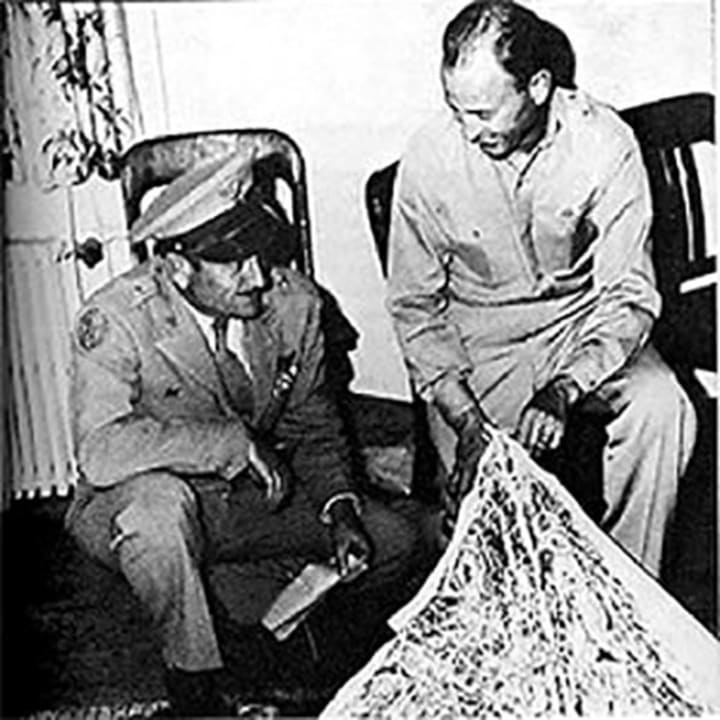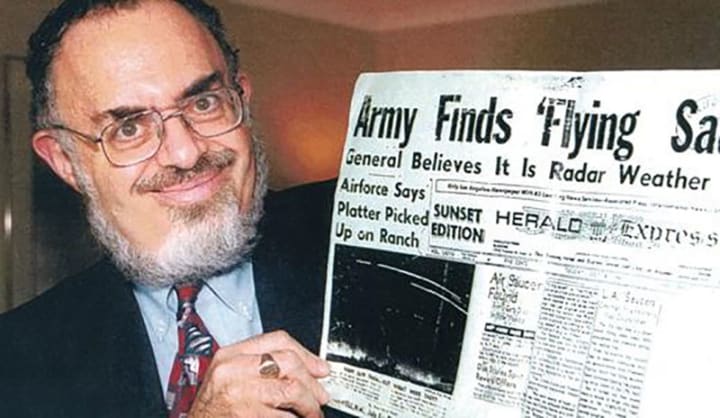A Crash Course on Roswell
Was the most famous UFO case even a UFO?

The Roswell incident is known worldwide. It also remains one of the most compelling UFO cases in the modern UFO era. For those who may know the bare essentials, here's a primer on this deeply compelling and controversial case. For those veteran UFO enthusiasts out there... here is a refresher course with your morning coffee.
Straight out of an old fashioned horror movie, July 3rd boasted a rather dark and stormy night. Dan Wilmot, a business owner in Roswell, NM, was sitting on the front porch of his house with his wife, admiring the brilliant storm that surged through the pitch black skies. The lighting crackled with static perfection, loud crashes of thunder following behind. A few more streaks of wild electricity lit up the entire horizon and soon faded away. But Wilmot noticed one singular glowing ball of brightness hanging silently behind. It began to move towards them at incredible speeds. As it got closer, Wilmot could see that this was not just any light, but a solid object in the shape of what he would later describe as “saucer-like”. The object coasted through the sky and soon disappeared out of sight. Wilmot would report it to the Roswell Daily Record the following morning. But his report would soon be trumped by something much more incredible. The object he had seen the night prior had apparently crashed into the cold, vast desert, ushering in the most famous UFO incident of all time.

It was that morning that Mac Brazel, the foreman of the J.B. Foster Ranch just outside Roswell, rode his horse out to the fields to check on his sheep, fearing that some may have been scared and scattered in the storm the night before. As he rode deeper into the field, it wasn't the sheep that seemed to be scattered, but a brilliant excess of shiny debris all along the pastures. The shiny material glistened in the morning sun, and Mac Brazel was quick to gather some of it and bring it home to show some of his friends and neighbors. He would eventually contact the local authorities, who in return, suspecting that it might be something military, contacted the authorities at Roswell Army Air Field.
Major Jesse Marcel, an Intelligence Officer at the 509th Bomb Group, would receive the call. He would personally go out to the field to investigate the matter. Upon viewing the wreckage, Marcel soon realized that this needed to be contained immediately. Soon, the entire field was stripped of the debris and quickly transported to Roswell Army Air Field.
A few days passed, and news broke about the incident in local newspapers. Soon, Colonel William Blanchard, Commander of the 509th Bomb Group, issued the first official press release, stating that a crashed disk had been recovered. But within hours, the statement was rescinded by a second press release that would this time be issued by General Roger Ramey, Commander of the Eighth Air Force, stating that Major Marcel had mistaken the wreckage for a crashed weather balloon and radar reflector. A famous photo was taken of Marcel and Ramey hunched over the supposed weather balloon wreckage. But many, many years later, Marcel would state that when he placed the original material on Ramey's desk, Ramey took him out of the room to view a map of where the exact crash site had been. Upon returning to the office, Marcel noticed that the material he had brought in had been replaced with shards of a weather balloon. Brig. Gen. Thomas Dubose, Chief of Staff of the Eighth Air Force was in the vicinity at the time, and has since gone on record, stating “It was a cover story. The whole balloon part of it. That was the part of the story we were told to give to the public and that was it.”

General Roger Ramey (Left) and Major Jesse Marcel (Right) with the "wreckage"
The Roswell incident was kept under tight cover after the two controversial press releases. Direct personnel involved with the recovery efforts, the transport of wreckage to Fort Worth, Texas, and those who spoke out about the possibility of so-called “non-human” bodies being seen at the site, were shipped off to destinations across the globe or simply disappeared. It seems that the powers that be were swiftly covering up something much more important than a mere weather balloon accident. The cover-up had worked, and decades upon decades passed before a chance encounter in 1978 between Nuclear Physicist and author, Stanton T. Friedman, and a now retired Major Jesse Marcel. Friedman would go on to interview Marcel about his participation in the entire event, and soon, he and many other authors were starting to take notice. Articles, books, interviews, and reports began to flood in, and by the early 1990s, Roswell was exploding into the mainstream.

Stanton T. Friedman, Nuclear Physicist
Quick to put a lid on the case yet again, the Air Force itself published a report about the incident titled, Roswell Report: Case Closed (The Official United States Air Force Report). In this 250 page publication, every part of the story was essentially debunked, disclosing that it had been a secret spy balloon known as Project MOGUL, and that the alleged bodies were nothing more than test dummies. These claims by the Air Force have been rebuked by UFO researchers, and vice-versa, causing the debate to wage on.

Sadly, anyone directly involved with the Roswell incident began a slow race with the undertaker, inevitably assuring that any first-hand account would soon fade into oblivion. That being said, without the unearthing of this extremely important case that simply could have fizzled only days after it occurred, arguably remains one of the most widely publicized, investigated, and most important UFO cases of all time.
- - -
Ryan Sprague is the author of 'Somewhere in the Skies: A Human Approach to an Alien Phenomenon' (Available on Amazon). He's written for Open Minds Magazine, Phenomena Magazine, and UFO Truth Magazine. Speaking on the UFO topic, he has been featured on ABC News, Fox News, and The Science Channel. He is a regular on the Travel Channel's 'Mysteries at the Museum'. When not writing, he is the co-host for both the 'Into the Fray' & 'UFOmodPOD' podcasts, available on iTunes. Learn more at www.somewhereintheskies.com
About the Creator
Ryan Sprague
Ryan Sprague is the author of 'Somewhere in the Skies: A Human Approach to an Alien Phenomenon'. He is also a UFO journalist, TV personality, and a podcaster. More at www.somewhereintheskies.com






Comments
There are no comments for this story
Be the first to respond and start the conversation.